May 2, 2014
Do We Have Diverse Books?
The hashtag #WeNeedDiverseBooks has been blowing up on Twitter this week. The idea is to give visibility (literally, photographs) to how little racial, gender, identity and ability diversity exists in publishing on all levels. We need diverse books, but we also need diverse stories, editors, publishers, agents and booksellers (eloquently elaborated upon by Daniel José Older on Buzzfeed and Bogi Takács both on eir blog and in Strange Horizons). No matter how you cut it, we need to see every face of humanity when we turn to a book.
Pictures are great, but is our money where our mouths are? I thought I’d take a trip around my own bookstore to have a look. I feel as if we offer a diverse selection of writers, but until you really take a calculator to it, you never really know. So here’s a case study based on our frontlist fiction shelf. These are the hardcovers on display at the very front of my store as of 10am on Friday, May 2nd 2014. This is what greets the buyer when they walk through the door.
Three Brothers by Peter Ackroyd (British Male)
Unnecessary Woman by Rabih Alameddine (Lebanese-American Male)
Forgiving the Angel by Jay Cantor (American Male)
The Luminaries by Eleanor Catton (Canadian-born New Zealand Female)
Every Day is for the Thief by Teju Cole (Nigerian-American Male)
Independence by Cecil Foster (Barbadian Canadian Male)
Andrew’s Brain by E.L. Doctorow (American Male)
Falling Out of Time by David Grossman (Israeli Male)
Boy in the Twilight by Yu Hua (Chinese Male)
The Wretched by Victor Hugo (French Male)
Fire in the Unnameable Country by Ghalib Islam (Bangladeshi Canadian Male)
In The Slender Margin by Eve Joseph (Canadian Female)
Kinder Than Solitude by Yiyun Li (Chinese American Female)
All Our Names by Dinaw Mengestu (Ethiopian-American Male)
Caught by Lisa Moore (Canadian Female)
Bark by Lorrie Moore (American Female)
Dust by Yvonne Adhiambo Owuor (Kenyan Female)
Between Friends by Amos Oz (Israeli Male)
Orfeo by Richard Powers (American Male)
Lovers at the Chameleon Club by Francine Prose (American Female)
Light and Dark by Natsume Soseki (Japanese Male)
The Valley of Amazement by Amy Tan (American Female)
All My Puny Sorrows by Miriam Toews (Canadian Female)
The Ever After of Ashwin Rao by Padma Viswanathan (Canadian Female)
Medicine Walk by Richard Wagamese (Ojibway Canadian Male)
By the Numbers:
In the interests of not spending all day picking into the personal lives of writers, I have decided to count only the most visible forms of diversity – race and presented gender. That will be what the readers sees when they pick up the book. Will they see people like themselves?
TOTAL # OF TITLES – 25
# Male – 15
# Female – 10
Country of Origin:
United States of America- 6
Canada – 6
Israel – 2
China – 2
Barbados – 1
Britain – 1
Lebanon – 1
Nigeria – 1
France – 1
Bangladesh – 1
Ethiopia – 1
Kenya – 1
Japan – 1
Visibly “white” – 13
Visibly a “Person of Colour” – 12
Biggest single group: White American Men, at 3.
*
Some notes:
I have opted to count writers by their country of birth rather than current residence because writers with solid literary reputations tend to be snapped up by big American universities. Ngũgĩ wa Thiong’o is currently tenured at New York University and University of California, Irvine – I don’t think anyone would argue that he is not a Kenyan writer.
“Visibly white” is tricky business. I counted both Israeli men as “white”, though Grossman and Oz are both Middle Eastern Jews who write in Hebrew. They are clearly writing from a different place than Richard Powers or Victor Hugo.
Two-thirds of these displayed writers are men, but I should note our two biggest bestsellers of the quarter are Donna Tartt’s The Goldfinch and Emma Donoghue’s Frog Music. These are not listed because they are sold out.
What does this mean for diversity? I think this looks good by a very low bar. We probably have one of the more diverse selections of books out there, but it is STILL a list in which more than half of the books are written by the dominant racial group. Putting aside countries of origin, a full 40% of them are American.
(Another 32% are Canadian, giving the North American contingent 72% of this shelf’s space – though this is mostly to do with the intricacies of publishing rights. We deal with Canadian distributors and Canadian publishers, who publish primarily domestic writers. International lists & translations do not make up the bulk of what they do. Another reason why “country of origin” is a more useful measure of diversity here: we want to see the faces of our neighbours, who are Canadian no matter how else they identify.)
Older asks us – those of us in the industry – to ask ourselves what we can do to make things better. What can we read, review, buy, sell? We carry fiction as a public service here – we don’t sell a tonne of it. We have it because we should, and when someone comes in looking, we want to be able to say yes. So we aren’t going to stop carrying Jay Cantor or E.L. Doctorow. These are good books. But we can add more good books. We take our cues from reviews, mentions in the newspaper, and customer requests. Last year one of our biggest fiction sellers was We Need New Names by Zimbabwean writer NoViolet Bulawayo because it got the buzz, and serious readers follow buzz.
To beat that dead horse, write reviews. Blog about what you’ve read. Pitch those reviews to the magazines and papers. Show the industry what’s good and nudge the buyers who’ll tell them what sells. Making a Top Ten Books That Do Something For Me list? Make sure it represents. If it doesn’t, wonder about what you’re reading. You are the mouth, my friends. We all are.
April 15, 2014
Five Great Heroes for Small Girls
Navigating media with a young girl can be a disheartening experience. If you think representation matters, like I do, you’re constantly on the lookout for smart, confident, diverse girls represented in interesting ways. They can be hard to find, but not impossible. Six years in, I have built a small but sturdy library.
Pippi Longstocking
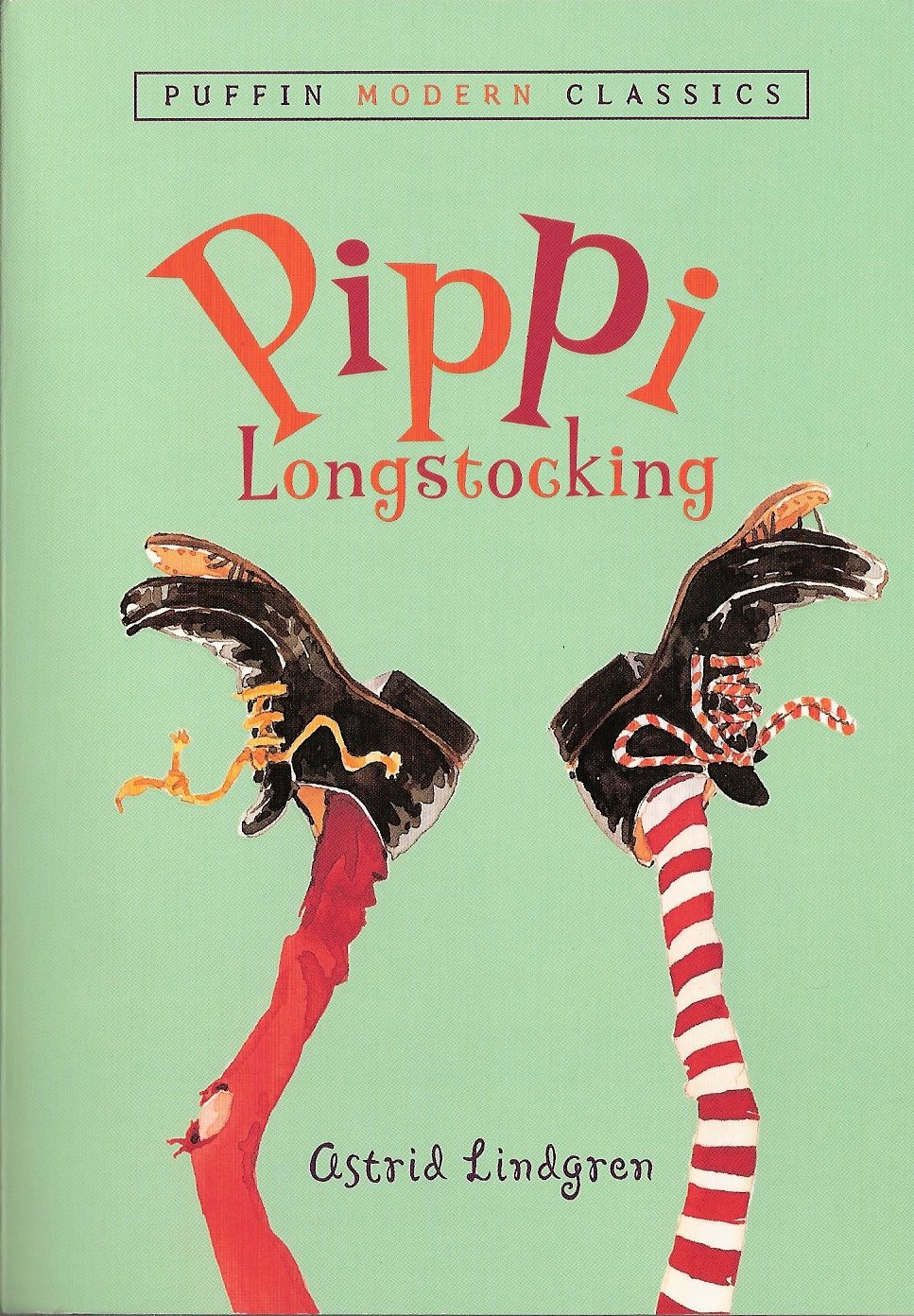 Pippi Longstocking, the hero of Astrid Lindgren’s eponymous books, was my #1 most favourite female hero for kids before I actually had kids. There were very few characters I, personally, identified with more when I was eight. Pippi lives alone with a horse and a monkey. She has incredible super-strength, which is neat, but not nearly as enticing as her independence. She has a father somewhere, distantly, who is a buccaneer captain. Pippi isn’t bothered by her father’s absence since he is alive and merely busy having adventures, so Pippi’s feral independence isn’t darkened in any way by loss or grief. She just straight up gets to do anything she likes, and does.
Pippi Longstocking, the hero of Astrid Lindgren’s eponymous books, was my #1 most favourite female hero for kids before I actually had kids. There were very few characters I, personally, identified with more when I was eight. Pippi lives alone with a horse and a monkey. She has incredible super-strength, which is neat, but not nearly as enticing as her independence. She has a father somewhere, distantly, who is a buccaneer captain. Pippi isn’t bothered by her father’s absence since he is alive and merely busy having adventures, so Pippi’s feral independence isn’t darkened in any way by loss or grief. She just straight up gets to do anything she likes, and does.
Mosca Mye
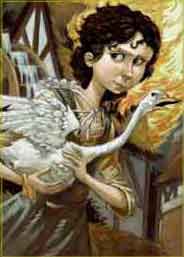 Mosca Mye is the hero of Frances Hardinge’s incredible books, Fly By Night and Twilight Robbery. Another lone, independent 12-year-old, Mosca does have a darker past, and it adds a definite edge to her character. Razor-sharp, Mosca escapes her dull relatives after sort-of-accidentally-on-purpose burning her uncle’s barn to the ground and freeing the loquacious conman, Eponymous Clent, who comes to be her partner in crime. She also has a goose named Saracen, who is the fiercest creature in all the world. Mosca’s not old enough to have lost a childlike innocence, despite her street smarts, and she survives all sorts of dangerous encounters on wit alone. Bonus points for major themes of literacy!
Mosca Mye is the hero of Frances Hardinge’s incredible books, Fly By Night and Twilight Robbery. Another lone, independent 12-year-old, Mosca does have a darker past, and it adds a definite edge to her character. Razor-sharp, Mosca escapes her dull relatives after sort-of-accidentally-on-purpose burning her uncle’s barn to the ground and freeing the loquacious conman, Eponymous Clent, who comes to be her partner in crime. She also has a goose named Saracen, who is the fiercest creature in all the world. Mosca’s not old enough to have lost a childlike innocence, despite her street smarts, and she survives all sorts of dangerous encounters on wit alone. Bonus points for major themes of literacy!
Zahrah the Windseeker
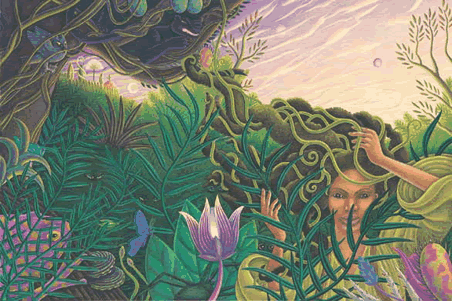 I’m partial to bold, independent heroes, but my elder daughter is a different creature. Adventures are scary to her, even when they come out well in the end, and so she instantly attached herself to Nnedi Okorafor-Mbachu’s Zahrah the Windseeker (winner of the 2008 Wole Soyinka Prize for Literature in Africa). Zahrah’s a shy, contemplative 13-year-old who is absolutely reluctant to go charging off into danger. She needs to think, internalize and understand – and occasionally be given a final firm shove. But she has strength of character and wisdom beyond her years, not to mention SHE CAN FLY, which is obviously amazing.
I’m partial to bold, independent heroes, but my elder daughter is a different creature. Adventures are scary to her, even when they come out well in the end, and so she instantly attached herself to Nnedi Okorafor-Mbachu’s Zahrah the Windseeker (winner of the 2008 Wole Soyinka Prize for Literature in Africa). Zahrah’s a shy, contemplative 13-year-old who is absolutely reluctant to go charging off into danger. She needs to think, internalize and understand – and occasionally be given a final firm shove. But she has strength of character and wisdom beyond her years, not to mention SHE CAN FLY, which is obviously amazing.
Kiki
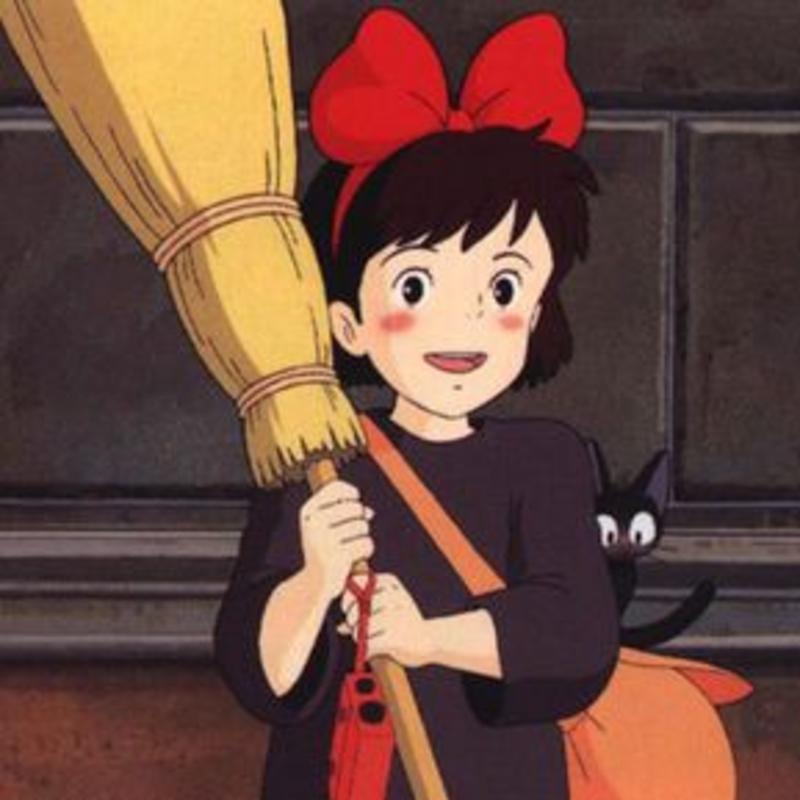 It would be easy to make this a list of characters from Hayao Miyazaki’s Studio Ghibli films, but let’s stick to one. Kiki is probably the strongest of Miyazaki’s characters. The film is about her and her growth as a character, and very little else. But it’s enough. Kiki’s independent, but less sure than some of the more assertive characters. She’s a witch, but she doesn’t know what her special skill is yet, and she quickly learns she isn’t as rich or fancy as other girls in the big city she has chosen to live in. Her fears and struggles are terrible relatable, though Kiki never sacrifices her fundamental goodness. Though she’s almost a young woman, the film’s lack of a “bad guy” makes it wonderful for kids of any age.
It would be easy to make this a list of characters from Hayao Miyazaki’s Studio Ghibli films, but let’s stick to one. Kiki is probably the strongest of Miyazaki’s characters. The film is about her and her growth as a character, and very little else. But it’s enough. Kiki’s independent, but less sure than some of the more assertive characters. She’s a witch, but she doesn’t know what her special skill is yet, and she quickly learns she isn’t as rich or fancy as other girls in the big city she has chosen to live in. Her fears and struggles are terrible relatable, though Kiki never sacrifices her fundamental goodness. Though she’s almost a young woman, the film’s lack of a “bad guy” makes it wonderful for kids of any age.
Zita the Space Girl
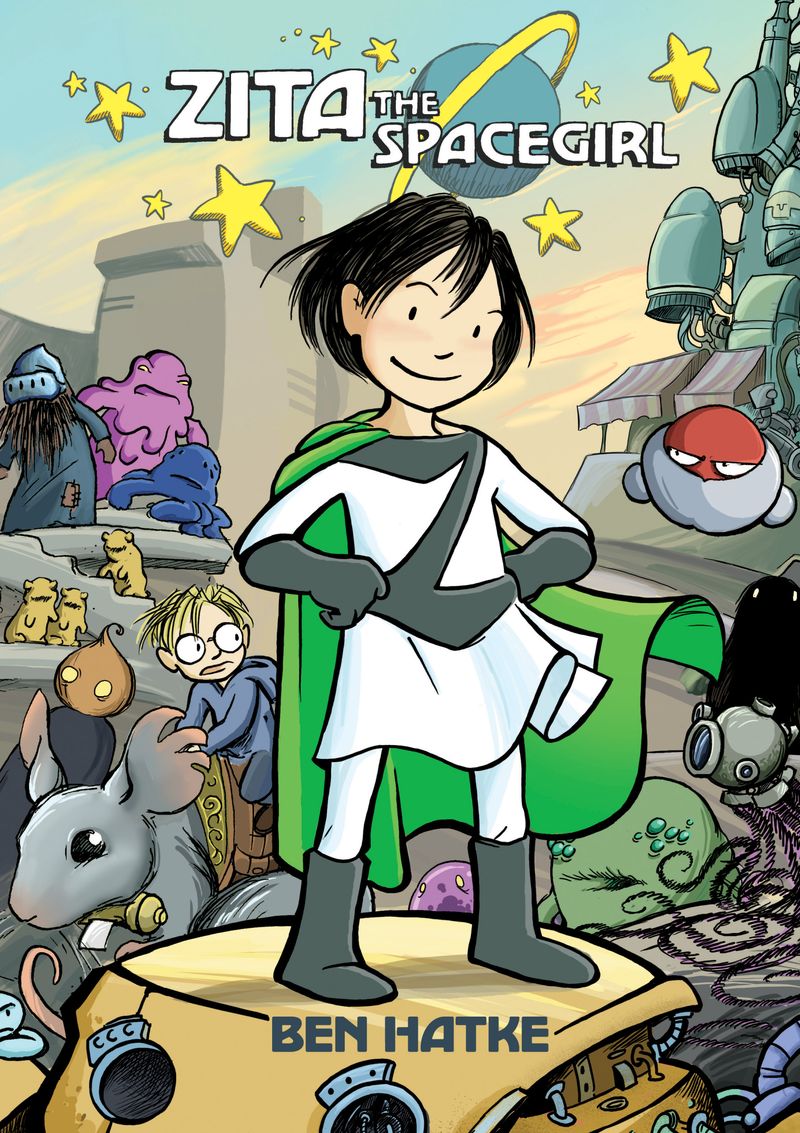 Ben Hatke’s Zita the Spacegirl (along with the sequels Legends of Zita the Spacegirl and The Return of Zita the Spacegirl) has pretty much everything you can ask for in space opera, pared down to the innocent scale of a young girl. Zita has arrived on a strange planet via a portal triggered by her best friend. He’s abducted: she dives through to rescue him. Instantly she’s thrown into huge, galaxy-spanning plots, con artistry, large scale rescue missions, desert crossings, overthrowing governments, salvaging robots, riding giant mice, standing up for economic refugees – have I missed anything? Probably – Zita almost has too much going on, but this never bothered my kids. Zita’s powers are pluck and the moral high ground – and it works.
Ben Hatke’s Zita the Spacegirl (along with the sequels Legends of Zita the Spacegirl and The Return of Zita the Spacegirl) has pretty much everything you can ask for in space opera, pared down to the innocent scale of a young girl. Zita has arrived on a strange planet via a portal triggered by her best friend. He’s abducted: she dives through to rescue him. Instantly she’s thrown into huge, galaxy-spanning plots, con artistry, large scale rescue missions, desert crossings, overthrowing governments, salvaging robots, riding giant mice, standing up for economic refugees – have I missed anything? Probably – Zita almost has too much going on, but this never bothered my kids. Zita’s powers are pluck and the moral high ground – and it works.
*
I’ve had a thing or two to say about good representations for young girls before, and my essay “The Princess Problem” is now available as part of Jim C. Hines’ Invisible: Personal Essays on Representation in SF/F. Proceeds from the sale of the book will be donated to Con or Bust, a fund administered through the Carl Brandon Society that helps get people of color/non-white people to attend SFF conventions. Take a look! Excellent work within.
